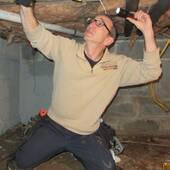Home inspectors in New Jersey should check for good functional water pressure at the fixtures in the home they are inspecting. Multiple fixture tests should be performed to determine if good water flow or pressure exists when multiple fixtures in the home are operating simultaneously.
For this discussion we will focus on poor water pressure from private wells. Poor water pressure occurs often in homes that have private wells. I come across many homes with this issue while performing home inspections in NJ.
For well systems to operate properly there must be adequate pressure. For most well systems a well pump provides the water pressure that makes water flow from the fixtures in the house. Different pumps have different flow rates. The overall rate of water flow is directly related to the well pump capacity. If your home demands say 8 gallons per minute but you have a 5 gallon per minute well pump there will be less then expected water pressure at the fixtures.
Most homes with wells are designed with the use of a well pressure tank. These tanks are designed to have extra volumes of water on reserve so normal water flow demands don't require the pump to turn on. An example of a small demand is turning on a faucet for a few seconds to fill a glass. However, the tank cannot compensate for flow greater than the pump capacity.
If your water is supplied by municipal connection your location and the age of the pipe lines can impact water pressure in the home. If you live close to the end of the line or if the utility's piping is old, you may have to install a booster pump and pressure tank in your municipal water fed home.
Here are other ways to try to solve the issue of low water pressure in your well fed home.
There is a device called a constant pressure valve that can be installed between the well pump and the interior pressure tank. The valve will automatically adjust flow from the well pump to a preset pressure. The valve is a cost effective means to help increase pressure but it is not capable of increasing the flow rate greater than that of the pump.
Additional well pressure tank capacity can be added to meet high demands for water that are greater then the pump's capacity. Installing two tanks in tandem will have to be done by a plumbing professional. However this fix will not permanently solve the problem of the shower, dishwasher, and washing machine running at the same time.
Another solution is the well pump can be replaced with a variable speed pump. The motors of variable speed well pumps can operate two times faster than constant speed pumps. The speed at which the pump operates is in correlation with water demands. A sensor continually monitors pressure demands and adjusts the pump's rate of flow. Some variable speed pumps are slow at start up which eliminates power surges and reduces torque on the pump and well piping increasing the life of the pump motor.

Comments(2)